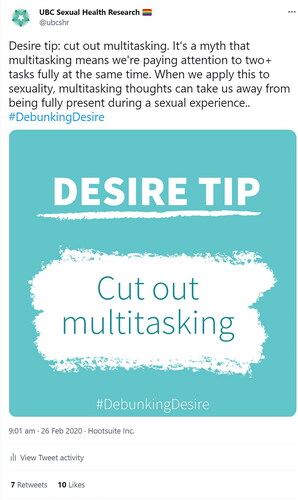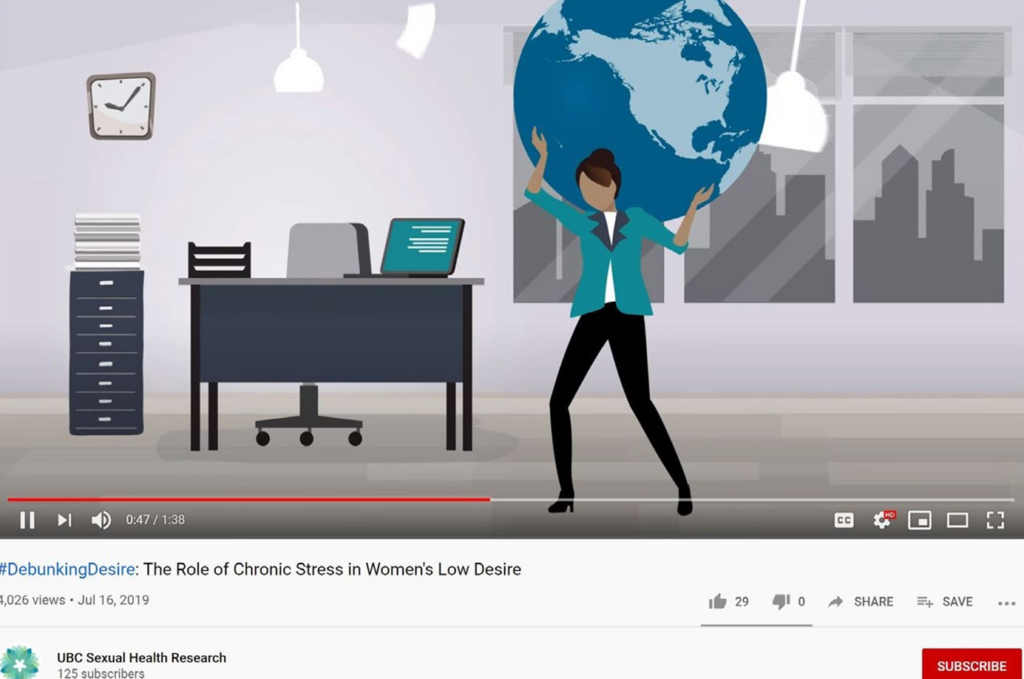“Approximately 1 in 3 women experience low sex desire” and most of them are going to turn to the internet for help.
Examining this self-help trend and how to use it to a researcher’s advantage is “#DebunkingDesire: A Sexual Science, Social Media, and Strategy in the Pursuit of Knowledge Dissemination” a campaign conducted by Brynn M. Lavery and an entire team of researchers and experts.
Published in the Journal of Sex & Marital Therapy, it reveals the efforts of the #DebunkingDesire campaign. Over ten months, they leveraged social media platforms to share knowledge about women’s sexual health and engage with a broader audience. The campaign generated over 300,000 social media impressions, participated in 11 podcasts, hosted eight online events, and attracted users from 110 countries.
The reality is that people are scrolling through places like #MedTok and #MedTwitter, so we need factual, evidence-based sexual health information to meet them there.
Sexual Interest/Arousal Disorder
Sexual Interest/Arousal Disorder (SIAD) is a condition that the DSM-5 recognizes and diagnosis when a woman experiences at least 3 out of 6 specific symptoms for 6 months or more. The symptoms are:
- Lack of interest in sexual activity
- Reduced erotic thoughts or fantasies
- Decreased initiation of sexual activity or response to partner’s advances
- Reduced pleasure during sexual activity
- Decrease in genital and non-genital sensations
“Many women who are distressed by their low sexual desire feel as though it cannot be changed or that it’s “just who they are.”” (#DebunkingDesire)
This condition is complex. Two women experiencing different symptoms can both meet the criteria for SIAD.
Many women are not reaching out for professional help, instead, they rely on the web and social media. The issue lies in Internet-based algorithms and large quantities of inaccurate information.
The Problem with Algorithms
Relying on social media to find solutions for sexual health issues can be tricky. Yes, they offer unparalleled accessibility and a sense of community but are riddled with pitfalls.
“Algorithms prioritize popular and often paid sites, not necessarily scientific ones.” (B.Lavery, et al.)

These algorithms lead to a spike in highly engaging content that may be less accurate, contributing to widespread misinformation. Trending influencers and well-funded campaigns can overshadow scientifically backed information, making it hard for users to determine the facts from fiction.
The #DebunkingDesire campaign sought to address the gap in trustworthy online resources. Such efforts are crucial in combating misinformation and ensuring the public receives accurate, helpful, and supportive information, including regarding their sexuality.
Knowledge-to-Action
The campaign used the Knowledge-to-Action framework. It’s a structured approach developed by the Canadian Institutes of Health Research, designed to connect what we know from research to its real-life applications. It involves creating and synthesizing knowledge and developing practical tools to share it.

Traditionally, it can take up to 17 years for new scientific knowledge to be widely implemented in clinical practice. This structured method thus significantly increases the speed at which scientists get the information to the public.
For #DebunkingDesire, the knowledge creation phase gathered the latest research on women’s sexual desire. Then, this information was turned into easily digestible content, like infographic videos and quizzes. The final stage was developing knowledge tools – practical resources that people could use, such as a comprehensive website and a social media toolkit.
The Multidisciplinary Team
The campaign was powered by a diverse and talented multidisciplinary team. This team included:
Clinician-Scientist: Provided research-based key messages
Knowledge Translation Manager: Specialized in women’s health research and managed the translation of research into practical content.
Social Media Strategist: Expert in spreading sexual health information across various social media platforms.
Patient Partner: Someone with lived experience of SIAD.
Social Media Assistant: Created and managed social media content.
Communications Assistant: Analyzed and interpreted social media metrics.
Research Trainees: Conducted literature reviews to inform key messages.
The team primarily disseminated information about women’s sexual well-being to a global audience on social media platforms like Twitter, Facebook, Instagram, and YouTube. These platforms were ideal for sharing user-generated content and dynamically engaging with its users.
#DebunkingDesire
The campaign kicked off with the creation of an infographic video that distilled key information about women’s sexual desires into a visually appealing and easy-to-comprehend format. It was hosted on the campaign’s YouTube channel and promoted across other social media platforms.
The team then launched a website as a central hub for all campaign activities. The website featured a true-or-false quiz that allowed users to test their knowledge about sexual desire, driving both engagement and education.

To amplify their message, they enlisted the help of social media influencers. These influencers shared original content about the campaign and promoted specific events and awareness days.
Additionally, the campaign utilized paid social media advertisements to promote their content.
Campaign Results
Overall, the campaign generated over 300,000 impressions across all social media platforms, with an engagement rate of 4-6%. This is significantly higher than the median engagement rate of average social media posts, typically below 1%.
Website Engagement
- 7,869 users visited the site, resulting in 20,038 pageviews.
- The website saw traffic from 110 countries with the highest visits from Turkey (37.55%), Canada (22.85%), and the United States (20.91%).
- The interactive quiz had a 66% completion rate.
Social Media Metrics
- Instagram: Posts generated 49,106 impressions, 2,314 likes, 173 URL clicks, 201 bookmarks, 213 direct messages, and 54 new followers.
- Facebook: Posts reached 34,947 users, creating 38,356 impressions and 2,245 engagements (likes, shares, comments).
- YouTube: The infographic video had 3,500 views, with viewers watching an average of 55.2%.
- Paid Advertisements: A Facebook ad campaign directed at Canadian women resulted in 2,743 URL clicks and reached 59,632 users.
Influencer and Podcast Collaborations
- Posts by three paid influencers generated 11,858 impressions on Twitter and 23,678 on Instagram.
- Participation in 11 podcasts led to 94,741 downloads and plays on platforms like Spotify and Apple Music, and 16,287 views on YouTube.
Subsequently, in the two years following the campaign, the website continued to attract users, with over 5,600 new users from 136 countries visiting the site and triggering 16,500 pageviews.
What Do We Learn From #DebunkingDesire?
The researchers recommend that “future campaigns should strive to create a dedicated community for continuous engagement.” This helps ensure that individuals looking for information on sexual health have reliable and ongoing support.

Second, they emphasize the importance of using a mix of social media platforms and traditional methods like podcasts to maximize reach and engagement. They point out that podcasts were particularly effective. Additionally, the campaign’s episodes were downloaded or played over 100,000 times, indicating a strong demand for factual and expert-delivered content.
Another learning is to involve patient partners from the start to create authentic content that resonates with the target audience. Patient partners can provide invaluable perspectives and help shape the campaign’s messages – making them relatable and impactful.
Lastly, the researchers push the need for constant evaluation and adaptation of the campaign strategies based on user feedback and engagement metrics. For example, podcasts were not part of the campaign’s initial strategy. The integration came after podcasters directly contacted the research team for collaboration. This approach kept the campaign relevant and effective in reaching its goals.
In today’s mass information age, we can’t wait 17 years for science to reach the public. We need it fast. We need it accurate. We need it on social media.



